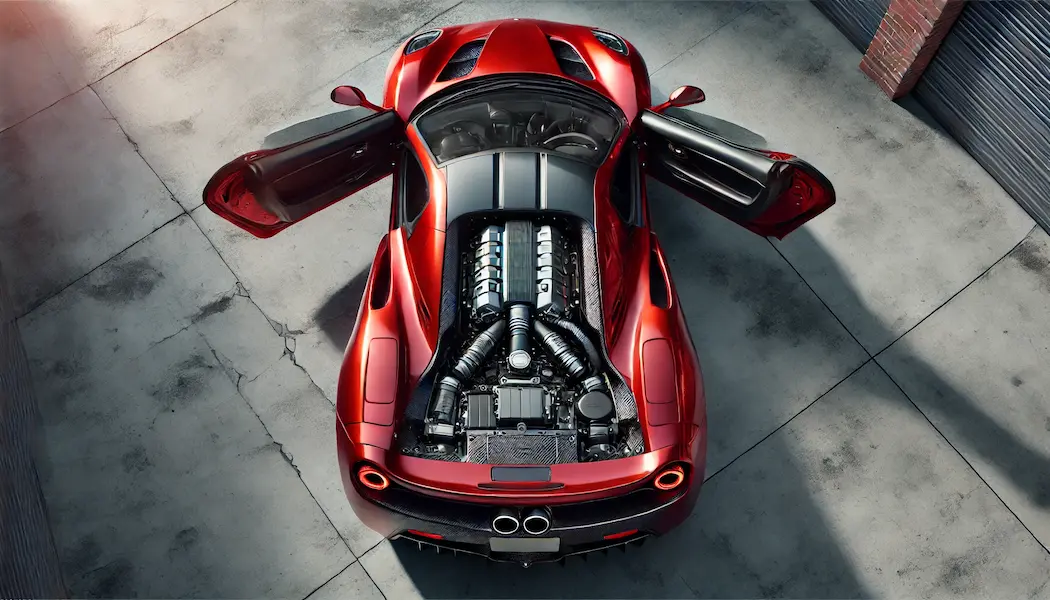Cars with Engine in Back: An Exciting Journey

Cars with engines in back, also known as rear-engine cars, have a unique place in automotive history. This layout means the engine is located behind the rear axle, providing distinct advantages and challenges. These cars have been loved by enthusiasts for their unique handling and innovative design.
The Basics of Rear-Engine Layout
In cars with engines in back, the engine is placed behind the rear axle. This configuration helps with traction and acceleration, as the weight of the engine presses down on the driven wheels. However, it can also lead to oversteer, where the back end of the car swings out during sharp turns. Rear-engine cars often have a different balance compared to front-engine cars, making them exciting to drive but sometimes tricky to handle.
Iconic Rear-Engine Cars
Several cars with engines in back have become icons over the years. These cars are known for their performance, design, and cultural impact. Here are some of the most notable ones:
Volkswagen Beetle
The Volkswagen Beetle, developed by Ferdinand Porsche in the 1930s, became one of the most successful cars ever. Its simple, reliable design and affordability made it a favorite worldwide. With over 21.5 million units produced, it remains a symbol of automotive history.
- Engine: 1.6-Liter Flat-four
- Horsepower: 57 HP
- Torque: 82 LB-FT
- Top Speed: 82 MPH
The Beetle was not just a car; it was a cultural icon. It represented freedom and adventure for many people, especially in the 1960s and 1970s. Its distinctive shape and reliability made it a beloved vehicle around the world.
Porsche 911
The Porsche 911 is perhaps the most famous car with an engine in back still in production today. Launched in 1963, it has gone through numerous iterations, each improving on its performance and design. The 911 is renowned for its thrilling driving experience and timeless design.
- Engine: Varies by model (Flat-six engines)
- Horsepower: Ranges from 370 HP to 700+ HP
- Top Speed: Varies (typically 180+ MPH for newer models)
Driving a Porsche 911 is a unique experience. Its rear-engine layout gives it a distinct balance, making it both challenging and rewarding to drive. The car’s legacy continues to grow with each new model, maintaining its status as a top sports car.
Engineering Marvels: Rear Mid-Engine Cars with Rear Seats
While most cars with engines in back are two-seaters, some engineers have managed to include rear seats. These cars are marvels of engineering, overcoming the challenge of fitting seats and an engine in the same space. Notable examples include:
Ferrari Mondial
The Ferrari Mondial is a stylish sports car with enough room for rear passengers. This makes it one of the few Ferraris that can comfortably seat four people. The Mondial’s design cleverly accommodates the engine and rear seats without compromising on performance.
- Engine: 3.0-Liter V8
- Horsepower: 214 HP
- Torque: 179 LB-FT
- Top Speed: 140 MPH
Lotus Evora
The Lotus Evora is known for its compact size and efficient use of space, making the rear seats functional for short trips. Despite its small footprint, the Evora provides a thrilling driving experience and enough room for occasional rear passengers.
- Engine: 3.5-Liter V6
- Horsepower: 276 HP
- Torque: 258 LB-FT
- Top Speed: 162 MPH
The Rise and Fall of Rear-Engine Cars
In the early days of the automobile, cars with engines in back were more common. However, by the 1970s, most manufacturers had moved away from this layout. The primary reasons include:
- Oversteer Issues: Cars with engines in back can be harder to control in sharp turns.
- Cooling Challenges: Properly cooling the engine in the back requires innovative solutions.
- Improved Front-Engine Designs: Advances in front-engine layouts provided better balance and interior space.
Rear-engine cars faced several engineering challenges that made them less practical for mass production. The tendency to oversteer was a significant safety concern, especially for less experienced drivers. Additionally, cooling a rear-mounted engine was more complicated, requiring specialized systems that added to the cost and complexity of the vehicle.
A Closer Look at Iconic Models
DeLorean DMC-12
The DeLorean DMC-12 is famous for its unique design and its role in the “Back to the Future” movies. With its stainless steel body and gull-wing doors, it looks like something from the future. Although it wasn’t a huge success when it was first made, it has since become a beloved classic.
- Engine: 2.85-Liter V-6
- Horsepower: 130 HP
- Torque: 153 LB-FT
- Top Speed: 109 MPH
The DeLorean’s distinctive design and cultural significance have made it a collector’s item. Its appearance in popular media has cemented its status as an icon, despite its relatively short production run.
Renault Alpine A110
The Renault Alpine A110 is a legendary sports car known for its light weight and excellent handling. Launched in 1961, it quickly became a favorite in the world of rally racing. The Alpine A110’s sleek design and powerful engine made it a standout on both the track and the road.
- Engine: 1.3-Liter Inline-4
- Horsepower: 120 HP
- Torque: 92 LB-FT
- Top Speed: 121 MPH
The Alpine A110 was a successful rally car, winning many competitions in its heyday. Its light and agile nature made it perfect for the demanding conditions of rally racing, and it remains a favorite among car enthusiasts.
The Technical Side: How Cars with Engines in Back Work
Cars with engines in back place the engine behind the rear axle. This positioning affects several aspects of the car’s performance:
- Traction: The engine’s weight on the rear wheels helps with traction during acceleration.
- Handling: Can lead to oversteer, where the rear of the car becomes more likely to swing out.
- Cooling: Rear engines need specialized cooling systems due to limited airflow.
The rear-engine layout offers unique advantages in terms of traction and acceleration. However, it also presents challenges, especially in terms of handling and cooling. Engineers have had to develop innovative solutions to manage these issues, making rear-engine cars both fascinating and complex.
Why Cars with Engines in Back Are Less Common Today
Modern cars have mostly shifted to front-engine or mid-engine layouts. Here are a few reasons why cars with engines in back have become rare:
- Safety Concerns: Oversteer can make rear-engine cars less stable.
- Technological Advances: Front-engine and mid-engine cars now offer better balance and space efficiency.
- Market Demand: Consumers prefer cars that are easier to handle and offer more interior space.
The decline of rear-engine cars can be attributed to several factors. Safety concerns, particularly related to oversteer, made these cars less appealing to the general public. Additionally, advancements in front-engine designs provided better overall balance and interior space, meeting consumer demands more effectively.
Future of Cars with Engines in Back
With the rise of electric vehicles (EVs), we might see a resurgence in cars with engines in back. Electric motors are more compact and can be placed in various configurations, including the back. This setup could bring back some of the benefits of cars with engines in back without the traditional drawbacks.
The Cultural Impact of Rear-Engine Cars
Rear-engine cars have left a big mark on car culture. They are often seen as unique and exciting. Models like the Porsche 911 and Volkswagen Beetle have become symbols of innovation and style. These cars are loved by car enthusiasts and have a special place in automotive history.
Benefits of Cars with Engines in Back
Cars with engines in back offer several advantages:
- Better Traction: The engine’s weight over the rear wheels helps with traction, especially during acceleration.
- Unique Handling: These cars provide a different driving experience, which many drivers find exciting.
- Compact Design: With the engine in the back, there’s more space for passengers and luggage in the front.
Challenges of Cars with Engines in Back
Despite their benefits, cars with engines in back also face some challenges:
- Oversteer: These cars can be harder to control in sharp turns.
- Cooling Issues: Keeping the engine cool in the back can be tricky.
- Less Common: Modern car designs have moved away from rear engines, making these cars rare.
Conclusion
Cars with engines in back have a fascinating history. From the iconic Volkswagen Beetle to the sleek Porsche 911, these cars offer a unique driving experience and innovative design. While they are less common today, their legacy continues to inspire car enthusiasts and designers. With new technology like electric vehicles, we might see a new era of cars with engines in back in the future. These cars remind us that sometimes, looking back can drive us forward.
Table of Key Rear-Engine Cars
| Car Model | Engine Type | Horsepower | Torque | Top Speed | Notable Features |
|---|---|---|---|---|---|
| Volkswagen Beetle | 1.6-Liter Flat-four | 57 HP | 82 LB-FT | 82 MPH | Affordable, cultural icon |
| Porsche 911 | Flat-six engines | 370-700+ HP | Varies | 180+ MPH | Legendary sports car, timeless design |
| Renault Alpine A110 | 1.3-Liter Inline-4 | 120 HP | 92 LB-FT | 121 MPH | Lightweight, successful rally car |
| DeLorean DMC-12 | 2.85-Liter V-6 | 130 HP | 153 LB-FT | 109 MPH | Stainless steel body, gull-wing doors |
| Hillman Imp | 0.875-Liter Inline-4 | 39 HP | 52 LB-FT | 85 MPH | Innovative aluminum engine, spacious interior |
| Chevrolet Corvair | 2.3-Liter Boxer-6 | 80-180 HP | 128-225 LB-FT | 95-110 MPH | Unique American rear-engine car, smooth ride |
Visit also: Cars with Best Engine: A Blend of Power, Reliability, and Innovation
Thanks for checking out this article on EngineEcho.com! Hope you found this article: "Cars with Engine in Back: An Exciting Journey" helpful! If you liked it and want to dive into more car engine topics, head over to our homepage. There's always something new to discover in the world of engines. Enjoy your reading journey!
Check out our previous article: Cars with Best Engine: A Blend of Power, Reliability, and Innovation






